Humminbird 718x Owner's Manual
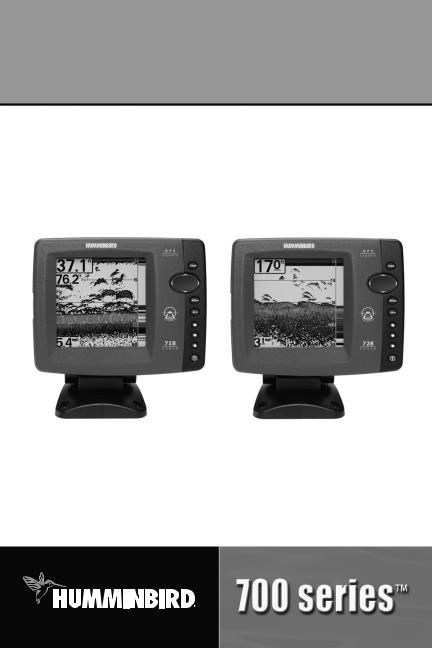
718 and 728 Operations Manual
531680-1_D

Thank You!
Thank you for choosing Humminbird®, America's #1 name in fishfinders.
Humminbird® has built its reputation by designing and manufacturing top-quality, thoroughly reliable marine equipment. Your Humminbird® is designed for trouble-free use in even the harshest marine environment. In the unlikely event that your Humminbird® does require repairs, we offer an exclusive Service Policy - free of charge during the first year after purchase, and available at a reasonable rate after the one-year period. For complete details, see the separate warranty card included with your unit. We encourage you to read this operations manual carefully in order to get full benefit from all the features and applications of your Humminbird® product.
Contact our Customer Resource Center at either 1-800-633-1468 or visit our web site at www.humminbird.com.
WARNING! This device should not be used as a navigational aid to prevent collision, grounding, boat damage, or personal injury. When the boat is moving, water depth may change too quickly to allow time for you to react. Always operate the boat at very slow speeds if you suspect shallow water or submerged objects.
WARNING! Disassembly and repair of this electronic unit should only be performed by authorized service personnel. Any modification of the serial number or attempt to repair the original equipment or accessories by unauthorized individuals will void the warranty.
WARNING! This product contains chemicals known to the state of California to cause cancer and/or reproductive harm.
WARNING! Do not travel at high speed with the unit cover installed. Remove the unit cover before traveling at speeds above 20 mph.
NOTE: Some features discussed in this manual require a separate purchase, and some features are only available on international models. Every effort has been made to clearly identify those features. Please read the manual carefully in order to understand the full capabilities of your model.
ENVIRONMENTAL COMPLIANCE STATEMENT: It is the intention of Humminbird® to be a responsible corporate citizen, operating in compliance with known and applicable environmental regulations, and a good neighbor in the communities where we make or sell our products.
WEEE DIRECTIVE: EU Directive 2002/96/EC “Waste of Electrical and Electronic Equipment Directive (WEEE)” impacts most distributors, sellers, and manufacturers of consumer electronics in the European Union. The WEEE Directive requires the producer of consumer electronics to take responsibility for the management of waste from their products to achieve environmentally responsible disposal during the product life cycle.
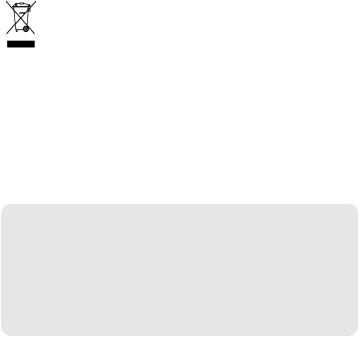
WEEE compliance may not be required in your location for electrical & electronic equipment (EEE), nor may it be required for EEE designed and intended as fixed or temporary installation in transportation vehicles such as automobiles, aircraft, and boats. In some European Union member states, these vehicles are considered outside of the scope of the Directive, and EEE for those applications can be considered excluded from the WEEE Directive requirement.
This symbol (WEEE wheelie bin) on product indicates the product must not be disposed of with other household refuse. It must be disposed of and collected for recycling and recovery of waste EEE. Humminbird® will mark all EEE products in accordance with the WEEE Directive. It is our goal to comply in the collection, treatment, recovery, and environmentally sound disposal of those products; however, these requirements do vary within European Union member states. For more information about where you should dispose of your waste equipment for recycling and recovery and/or your European Union member state requirements, please contact your dealer or distributor from
which your product was purchased.
ROHS STATEMENT: Product designed and intended as a fixed installation or part of a system in a vessel may be considered beyond the scope of Directive 2002/95/EC of the European Parliament and of the Council of 27 January 2003 on the restriction of the use of certain hazardous substances in electrical and electronic equipment.
ATTENTION INTERNATIONAL CUSTOMERS: Products sold in the U.S. are not intended for use in the international market. Humminbird® international units provide international features and are designed to meet country and regional regulations. Languages, maps, time zones, units of measurement, and warranty are examples of features that are customized for Humminbird® international units purchased through our authorized international distributors.
To obtain a list of authorized international distributors, please visit our web site at www.humminbird.com or contact our Customer Resource Center at (334) 687-6613.
700 Series™, Cannon®, CannonLink™, DualBeam PLUS™, Fish ID+™, Fishing GPS®, Humminbird®, HumminbirdPC™, InterLink™, QuadraBeam PLUS™, RTS™, RTS Window™, Structure ID®, Selective Fish ID+®, WeatherSense®, WhiteLine™, WideSide®, and X-Press™ Menu are trademarked by or registered trademarks of Humminbird®.
© 2010 Humminbird®, Eufaula AL, USA. All rights reserved.

Table of Contents |
|
How Sonar Works |
1 |
DualBeam PLUS™ Sonar .......................................................................................... |
3 |
QuadraBeam PLUS™ Sonar |
|
(with optional-purchase QuadraBeam PLUS™ transducer).............................................. |
4 |
WideSide® Sonar (with optional-purchase WideSide® transducer) .................................. |
5 |
Universal Sonar 2 ...................................................................................................... |
5 |
What’s On the Sonar Display |
6 |
Understanding the Sonar Display ............................................................................ |
8 |
Real Time Sonar (RTS™) Window ............................................................................ |
9 |
Freeze Frame and Active Cursor.............................................................................. |
10 |
Bottom Presentation ................................................................................................ |
11 |
Views |
13 |
Sonar View .............................................................................................................. |
16 |
Sonar Zoom View .................................................................................................... |
17 |
200/83 kHz Split Sonar View .................................................................................. |
18 |
Big Digits View ........................................................................................................ |
19 |
Circular Flasher View .............................................................................................. |
20 |
Side Beam View (with optional-purchase QuadraBeam PLUS™ transducer).................... |
21 |
WideSide® View (with optional-purchase WideSide® transducer) .................................. |
25 |
Using Your 700 Series™ Control Head |
26 |
Key Functions |
27 |
POWER/LIGHT Key .................................................................................................. |
27 |
VIEW Key ................................................................................................................ |
28 |
MENU Key .............................................................................................................. |
28 |
4-WAY Cursor Control Key ...................................................................................... |
29 |
VIEW PRESET Keys .................................................................................................. |
29 |
EXIT Key .................................................................................................................. |
30 |
i

Table of Contents |
|
Accessory Bus |
31 |
Powering On the Unit |
32 |
The Menu System |
33 |
Start-Up Options Menu |
34 |
Normal Operation .................................................................................................. |
35 |
Simulator .............................................................................................................. |
35 |
System Status ...................................................................................................... |
37 |
Self Test.................................................................................................................. |
37 |
Accessory Test........................................................................................................ |
38 |
PC Connect and Software Updates (with PC Connect cable only)............................ |
39 |
X-Press™ Menu |
40 |
Main Menu |
41 |
Quick Tips for the Main Menu .................................................................................. |
42 |
User Mode (Normal or Advanced) .............................................................................. |
43 |
Sonar X-Press™ Menu (Sonar views only) |
45 |
Side (WideSide® transducer: WideSide® View only) ...................................................... |
46 |
Sensitivity .............................................................................................................. |
47 |
Upper Range (Advanced: Sonar, Split Sonar, Big Digits and Circular Flasher views only).... |
48 |
Lower Range ........................................................................................................ |
49 |
Side Beam Range (WideSide® transducer: WideSide® View only)................................ |
50 |
Chart Speed .......................................................................................................... |
51 |
Quad Layout (with optional-purchase QuadraBeam PLUS™ Transducer, |
|
Side Beam View only) ............................................................................................ |
51 |
Bottom View .......................................................................................................... |
52 |
Bottom Lock (Sonar Zoom view only) ........................................................................ |
53 |
Bottom Range (Sonar Zoom view only when Bottom Lock is On) ................................ |
53 |
Zoom Level (Sonar Zoom view only) .......................................................................... |
54 |
ii

Table of Contents |
|
Alarms Menu Tab |
55 |
Depth Alarm ............................................................................................................ |
56 |
Fish ID Alarm............................................................................................................ |
56 |
Low Battery Alarm .................................................................................................. |
57 |
Aux. Temp. Alarm (with optional-purchase temp. probe or Temp/Speed only) ................ |
57 |
Temp. Alarm ............................................................................................................ |
58 |
Alarm Tone .............................................................................................................. |
58 |
Sonar Menu Tab |
59 |
Beam Select ............................................................................................................ |
60 |
Fish ID+™ ................................................................................................................ |
61 |
Fish ID Sensitivity .................................................................................................... |
62 |
Real Time Sonar (RTS™) Window .......................................................................... |
62 |
Zoom Width.............................................................................................................. |
63 |
83 kHz Sensitivity (Advanced).................................................................................... |
63 |
455 kHz Sensitivity (Advanced: with QuadraBeam PLUS™ transducer) .......................... |
64 |
WideSide® Sensitivity (Advanced: with WideSide® transducer) .................................... |
65 |
Depth Lines (Advanced) ............................................................................................ |
66 |
Surface Clutter (Advanced) ........................................................................................ |
67 |
Noise Filter (Advanced) .............................................................................................. |
68 |
Max Depth (Advanced) .............................................................................................. |
68 |
Water Type (Advanced) .............................................................................................. |
69 |
Transducer Select .................................................................................................... |
69 |
iii

Table of Contents |
|
Setup Menu Tab |
70 |
Units - Depth.......................................................................................................... |
71 |
Units - Temp (International only) .............................................................................. |
71 |
Units - Distance .................................................................................................... |
71 |
Units - Speed ........................................................................................................ |
72 |
User Mode ............................................................................................................ |
72 |
Language (International only).................................................................................... |
72 |
Triplog Reset ........................................................................................................ |
73 |
Restore Defaults .................................................................................................... |
73 |
Select Readouts (Advanced, Sonar view only) .......................................................... |
74 |
Depth Offset (Advanced).......................................................................................... |
76 |
Aux. Temp. Offset (Advanced) ................................................................................ |
76 |
Temp. Offset (Advanced).......................................................................................... |
77 |
Speed Calibration (Advanced, with Temp/Speed only) .............................................. |
77 |
Local Time Zone (Advanced) .................................................................................... |
78 |
Daylight Saving Time (Advanced)............................................................................ |
78 |
Time Format (Advanced, International only)................................................................ |
79 |
Date Format (Advanced, International only)................................................................ |
79 |
Digits Format (Advanced) ........................................................................................ |
80 |
NMEA Output (Advanced) ...................................................................................... |
80 |
Views Menu Tab |
82 |
Accessories Menu Tab |
83 |
iv

Table of Contents |
|
Troubleshooting |
84 |
Fishing System Doesn’t Power Up.......................................................................... |
84 |
Fishing System Defaults to Simulator with a Transducer Attached .................... |
84 |
Display Problems...................................................................................................... |
85 |
Finding the Cause of Noise .................................................................................... |
86 |
700 Series™ Fishing System Accessories |
87 |
Specifications |
89 |
Glossary |
90 |
Contact Humminbird® |
102 |
NOTE: Entries in this Table of Contents which list (International Only) are only available on products sold outside of the U.S. by our authorized international distributors. To obtain a list of authorized international distributors, please visit our web site at www.humminbird.com or contact our Customer Resource Center at
(334) 687-6613.
NOTE: Entries in this Table of Contents which list (with PC Connect Cable only) or (with Temp/Speed only) require the purchase of separate accessories. You can visit our web site at www.humminbird.com to order these accessories online or contact our Customer Resource Center at 1-800-633-1468.
NOTE: Some features discussed in this manual require a separate purchase, and some features are only available on international models. Every effort has been made to clearly identify those features. Please read the manual carefully in order to understand the full capabilities of your model.
v
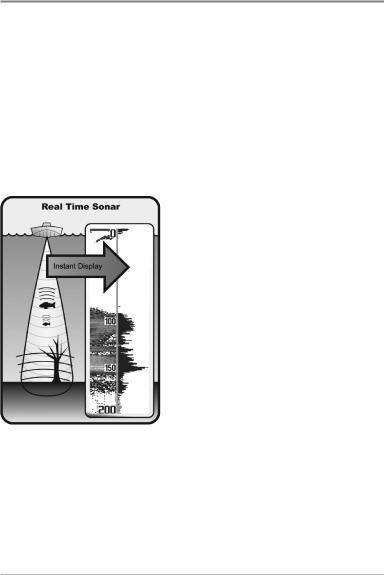
How Sonar Works
Sonar technology is based on sound waves. The 700 Series™ Fishing System uses sonar to locate and define structure, bottom contour and composition, as well as depth directly below the transducer.
Your 700 Series™ Fishing System sends a sound wave signal and determines distance by measuring the time between the transmission of the sound wave and when the sound wave is reflected off of an object; it then uses the reflected signal to interpret location, size, and composition of an object.
Sonar is very fast. A sound wave can travel from the surface to a depth of 240 ft (70 m) and back again in less than 1/4 of a second. It is unlikely that your boat can “outrun“ this sonar signal.
SONAR is an acronym for SOund and NAvigation Ranging. Sonar utilizes precision sound pulses or “pings“ which are emitted into the water in a teardrop-shaped beam.
The sound pulses “echo“ back from objects in the water such as the bottom, fish, and other submerged objects. The returned echoes are displayed on the LCD screen. Each time a new echo is received, the old echoes are moved across the LCD, creating a scrolling effect.
1 |
How Sonar Works |
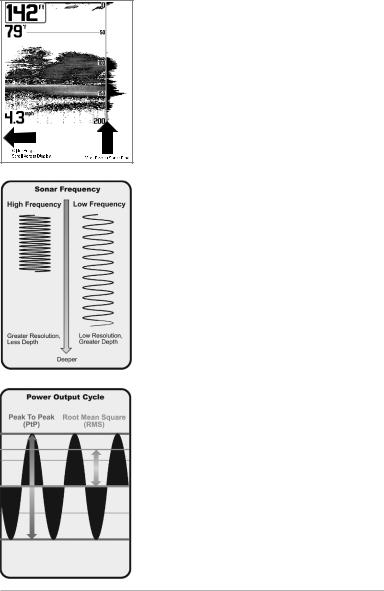
When all the echoes are viewed side by side, an easy to interpret “graph“ of the bottom, fish, and structure appears.
The sound pulses are transmitted at various frequencies depending on the application. Very high frequencies (455 kHz) are used for greatest definition but the operating depth is limited. High frequencies (200 kHz) are commonly used on consumer sonar and provide a good balance between depth performance and resolution. Low frequencies (83 kHz) are typically used to achieve greater depth capability.
The power output is the amount of energy generated by the sonar transmitter. It is commonly measured using two methods:
•Root Mean Square (RMS) measures power output over the entire transmit cycle.
•Peak to Peak measures power output at the highest points.
The benefits of increased power output are the ability to detect smaller targets at greater distances, ability to overcome noise, better high speed performance and enhanced depth capability.
How Sonar Works |
2 |
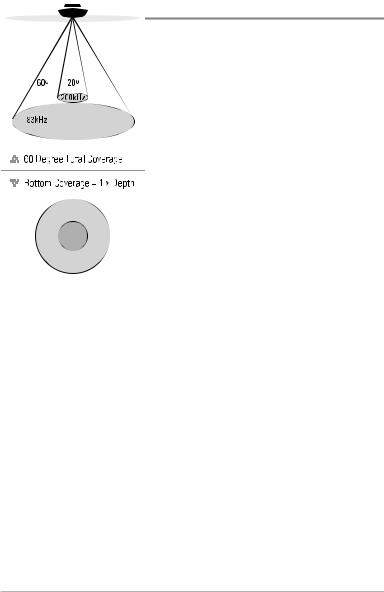
DualBeam PLUS™ Sonar
Your 700 Series™ Fishing System uses a 200/83 kHz DualBeam PLUS™ sonar system with a wide (60°) area of coverage. DualBeam PLUS™ sonar has a narrowly focused 20° center beam, surrounded by a second beam of 60°, expanding your coverage to an area equal to your depth. In 20 feet of water, the wider beam covers an area 20 feet wide. DualBeam PLUS™ sonar returns can be blended together, viewed separately, or compared side-by-side. DualBeam PLUS™ is ideal for a wide range of conditions - from shallow to very deep water in both fresh and salt water. Depth capability is affected by such factors as boat speed, wave action, bottom hardness, water conditions and transducer installation.
3 |
How Sonar Works |

35° |
60° |
20° |
35° |
455 kHz |
|
200 kHz |
455 kHz |
|
|
|
83 kHz


 90° Total Coverage
90° Total Coverage


 Bottom Coverage = 2 x Depth
Bottom Coverage = 2 x Depth
QuadraBeam PLUS™ Sonar
(with optional-purchase QuadraBeam PLUS™ transducer)
Your 700 Series™ Fishing System also supports QuadraBeam PLUS™ sonar with the purchase of an additional QuadraBeam PLUS™ transducer. QuadraBeam PLUS™ sonar provides an extremely wide 90° area of coverage. QuadraBeam PLUS™ starts with two fan-shaped 35° 455 kHz Side Structure locating sonar beams to spot fish, bait, and structure to the left and right of the boat over an area of the bottom that’s always equal to twice your depth. For a detailed view below the boat, QuadraBeam PLUS™ uses DualBeam PLUS™ technology, with precision 20° and wide 60° beams. QuadraBeam PLUS™ finds more fish faster and can even tell you where to put your bait by showing if fish are to the left, right, or directly beneath your boat.
How Sonar Works |
4 |
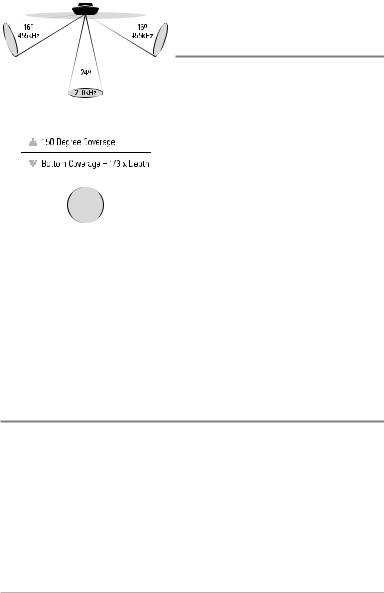
WideSide® Sonar
(with optional-purchase WideSide®
transducer)
Your 700 Series™ Fishing System also supports WideSide® sonar with the purchase of an additional WideSide® transducer. The WideSide® transducer is a specialized "side-looking" transducer that is extremely useful for bank fishing or looking for bait fish in open water. The WideSide® transducer uses three different sonar elements that transmit signals to the left, right, and straight down from your boat. The downward beam is 200 kHz with a 24° area of coverage. This beam maintains a continuous digital depth readout from the bottom directly beneath your boat. The side beams are 455 kHz with a 16° area of coverage. The side-looking elements can be used independently or together to locate targets near the surface of the water on either side of your boat.
Universal Sonar 2
(compatible w/ optional-purchase Minnkota trolling motors)
Your 700 Series™ Fishing System supports Universal Sonar 2, a state-of-the- art, integrated and protected transducer that is built into the lower unit of
Minnkota trolling motors. With Universal Sonar 2, all wiring is concealed inside the indestructible composite shaft—out of sight and out of harm’s way, with no clamps, ties, or exposed wires. Universal Sonar 2 features new temperature sensing and the performance of DualBeam PLUS™ technology (available with all Humminbird® DualBeam PLUS™ models). An expanded view and greater bottom detail gives you a totally new perspective of the water below, along with optimal sonar performance to help you find fish.
5 |
How Sonar Works |

What’s On the Sonar Display
The 700 Series™ Fishing System can display a variety of useful information about
Depth - water depth; can be set to alarm when the water becomes too shallow.
Speed - if a Temp/Speed accessory or GPS Receiver is attached, the Fishing System can display the speed of the boat and can keep a Triplog of nautical or statute miles traveled.
Temperature - water surface temperature.
Timer - Elapsed time with Temp/Speed
Accessory or GPS Receiver.
Distance - Distance traveled with Temp/Speed
Accessory or GPS Receiver.
Average Speed - Average speed reading with
Temp/Speed Accessory or GPS Receiver.
Second Sonar Return - when the sonar signal bounces between the bottom and the surface of the water and back again. Use the appearance of the second return to determine bottom hardness. Hard bottoms will show a strong second return, while soft bottoms will show a very weak one or none at all.
Cursor Dialog Box - indicates cursor depth on the display and the depth of the bottom directly below the cursor. The Latitude and Longitude of the cursor position, the distance to travel to the cursor position, and the bearing to the cursor position is shown with a GPS receiver. A waypoint can be marked at the cursor position for later retrieval and use with a GPS receiver.
NOTE: Entries in this view that list (with Temp/Speed or GPS Receiver) are available if either device information from the GPS receiver will be displayed on the view.
What’s On the Sonar Display |
6 |
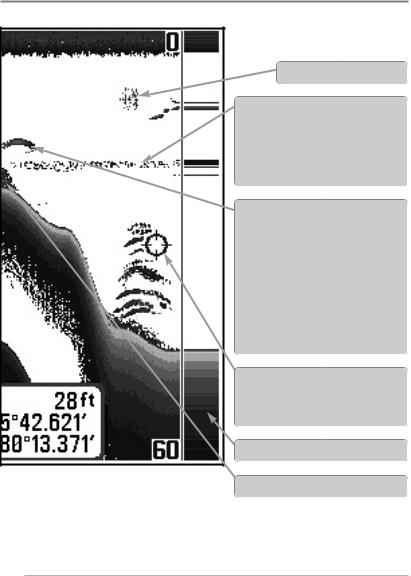
the area under and adjacent to your boat, including the following items:
Bait Ball
Thermoclines - layers of water with different temperatures that appear at different depths and different times of the year. A thermocline typically appears as a continuous band of gray levels moving across the display at the same depth.
Fish - the Fishing System displays fish as arches and/or fish icons, and can be set to alarm when a fish of a certain size is detected. When a target is detected, a Fish ID+™ symbol appears on the display with the depth displayed above it. The size of the symbol indicates the intensity of the sonar return. The unit will clearly show schools of Bait Fish as "clouds" of different shapes and sizes, depending on the number of fish and boat speed.
Cursor - available in Freeze Frame and can be positioned in the Sonar View to provide depth of a sonar return and bottom depth below the cursor.
RTS (Real Time Sonar) Window™
Structure - where fish may be hiding.
is connected to the 700 Series™ Fishing System. If both devices are connected, then only the
7 |
What’s On the Sonar Display |
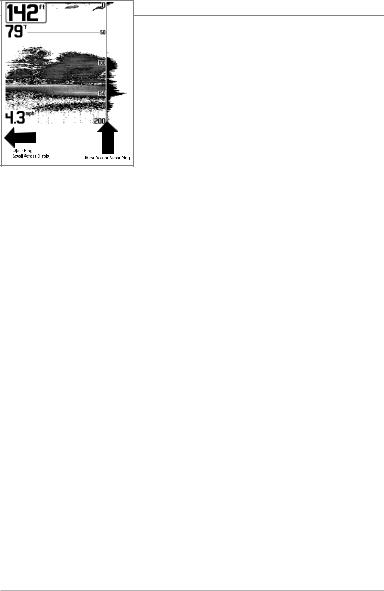
The returned sonar echoes are displayed on the screen. As a new echo is received, the historical data scrolls across the screen.
Understanding the Sonar Display
It is important to understand the significance of the display. The display does not show a literal 3- dimensional representation of what is under the water. Each vertical band of data received by the control head and plotted on the display represents something that was detected by a sonar return at a particular time. As both the boat and the targets (fish) may be moving, the returns are only showing a particular segment of time when objects were detected, not exactly where those objects are in relation to other objects shown on the display.
What’s On the Sonar Display |
8 |
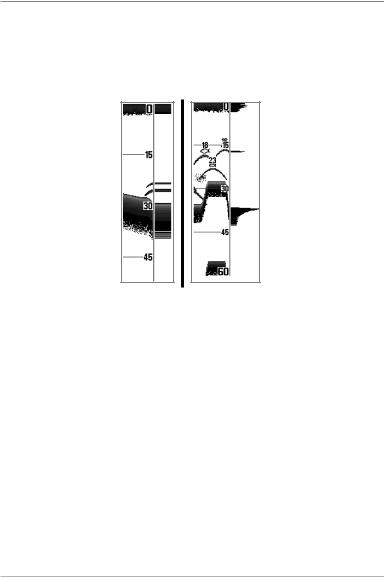
Real Time Sonar (RTS™) Window
A Real Time Sonar (RTS™) Window appears on the right side of the display in the Sonar View only. The RTS Window™ updates at the fastest rate possible for depth conditions and shows only the returns from the bottom, structure, and fish that are within the transducer beam. The RTS Window™ plots the depth and intensity of a sonar return (see Sonar Menu Tab: RTS Window™).
The Narrow RTS Window™ indicates the sonar intensity through the use of grayscale. The grayscale used matches the Bottom View grayscale setting (Inverse, StructureID®, WhiteLine™, Bottom Black). The depth of the sonar return is indicated by the vertical placement of the return on the display depth scale.
The Wide RTS Window™ indicates the sonar intensity through the use of a bar graph. The length of the plotted return indicates whether the return is weak or strong. The depth of the sonar return is indicated by the vertical placement of the return on the display depth scale. The Wide RTS Window™ does not use grayscale.
9 |
What’s On the Sonar Display |

Freeze Frame and Active Cursor
Freeze Frame & Active Cursor - Press any arrow on the 4-WAY Cursor Control key, and the screen will freeze and a cursor will be displayed. Use the 4-WAY Cursor Control key to move the cursor over a sonar return, and the depth of the sonar return will be displayed at the bottom of the screen in the cursor information box.
Instant Image Update - You can change a variety of sonar menu settings (such as Sensitivity or Upper Range), and the adjustments will be shown instantly on the screen. When combined with the Freeze Frame feature, you can adjust and see the effects of many different sonar settings quickly and easily.
The RTS Window™ continues to update in Freeze Frame. Pressing EXIT will exit Freeze Frame, and the display will start to scroll. Freeze Frame is available in the Sonar, Sonar Zoom, and 200/83 kHz Split Sonar Views.
What’s On the Sonar Display |
10 |

Bottom Presentation
As the boat moves, the unit charts the changes in depth on the display to create a profile of the Bottom Contour. The type of bottom can be determined from the return charted on the display. A Hard Bottom such as compacted sediment or flat rock appears as a thinner line across the display. A Soft Bottom such as mud or sand appears as a thicker line across the display. Rocky Bottoms have a broken, random appearance.
Bottom Contour Profile with RTS Window™
Hard Bottom
Soft Bottom
Rocky Bottom
The sonar returns from the bottom, structure, and fish can be represented as either Inverse, Structure ID®, WhiteLine™, or Black (Bottom Black). See Sonar X-Press™ Menu: Bottom View for details on how to set the bottom view.
11 |
What’s On the Sonar Display |
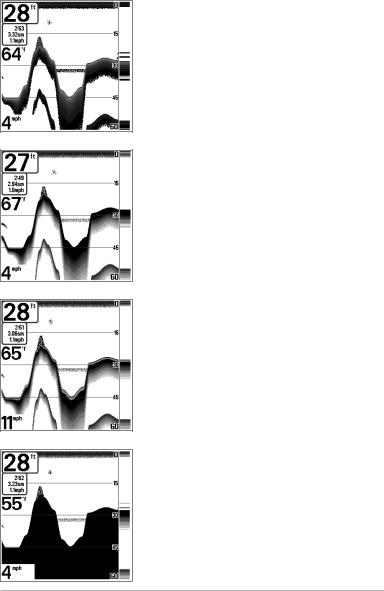
Inverse is a method where weak returns are shown with dark pixels and strong returns with lighter pixels. This has the benefit of ensuring that weak signals will be clearly visible on the display.
Structure ID® represents weak returns as light pixels and strong returns as dark pixels. This has the benefit of ensuring that strong returns will be clearly visible on the display.
WhiteLine™ highlights the strongest sonar returns in white resulting in a distinctive outline. This has the benefit of clearly defining the bottom on the display.
Black (Bottom Black) displays all pixels below the bottom contour as black, regardless of signal strength. This has the benefit of providing a high contrast between the bottom and other sonar returns on the display.
What’s On the Sonar Display |
12 |
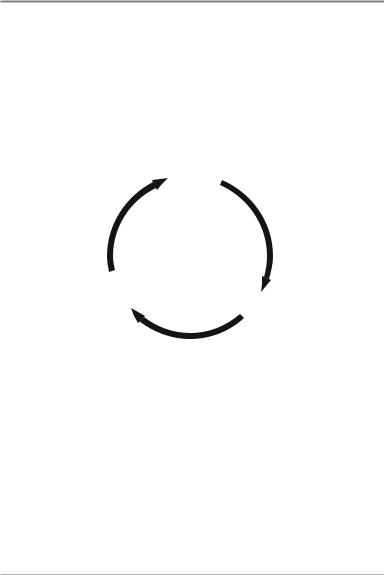
Views
The sonar information from your Fishing System is displayed on your screen in a variety of easy-to-read views. There are many views available on your Fishing System. When you press the VIEW key, the display cycles through the available views on your screen. When you press the EXIT key, the display cycles through the available views in reverse order.
When you first power up the control head, Sonar View will be the default view.
You can display and hide any view to suit your fishing preferences.
Accessory
Test View
Sonar
View
Sonar Zoom
View
Self Test |
|
|
|
|
|
Split Sonar |
View |
|
|
|
|
|
View |
|
|
|
|
|
||
WideSide View |
|
|
|
|
|
Big Digits |
(optional |
|
|
|
|
|
View |
WideSide |
|
|
|
|
|
|
required) |
|
|
|
|
|
|
Side Beam |
|
|
|
|
|
Circular Flasher |
View |
|
|
|
|
|
|
|
|
|
|
|
View |
|
(optional |
|
|
|
|
|
|
|
|
|
|
|
|
|
QuadraBeam |
|
|
|
|
|
|
required) |
|
|
|
|
|
|
NOTE: When you change any menu settings that affect the sonar, the view will update immediately. You don't have to exit the menu to apply the change to the screen.
NOTE: Side Beam View and WideSide® View require the purchase of the QuadraBeam PLUS™ transducer for the Side Beam View and the WideSide® transducer for the WideSide® View. You can visit our web site at www.humminbird.com to order these accessories online or contact our Customer Resource Center at 1-800-633-1468.
13 |
Views |

To customize your views rotation:
You can choose which views are hidden or visible in your view rotation.
1.Press the MENU key twice to access the tabbed Main Menu, then press the RIGHT Cursor key until the Views tab is selected.
2.Press the UP or DOWN Cursor keys to select a View.
3.Press the LEFT or RIGHT Cursor keys to change the status of the view from Hidden to Visible or vice versa.
To program each PRESET key:
Another way to access your favorite views quickly is to store them on the VIEW PRESET keys. Instead of using the VIEW key to cycle through every view to find the one you want, you can program the VIEW PRESET keys to display a specific view immediately.
1.Press the VIEW key to cycle to the view you want to store.
2.Press and hold one of the VIEW PRESET keys for several seconds. A chime will indicate that the view has been saved. You can store up to three views, one on each key.
To change the Digital Readouts:
Each view displays digital readout information (such as speed or time), which varies with the view selected and the accessory attached. The digital readouts on the Sonar View can be customized. See Setup Menu Tab: Select Readouts for more information.
1.Press the MENU key twice to access the tabbed Main Menu, then press the RIGHT Cursor key until the Setup tab is selected.
2.Press the DOWN key to highlight Select Readouts, and press the RIGHT Cursor key to access the Select Readouts submenu.
NOTE: If the Select Readouts option does not appear under the Setup tab, change the User Mode to Advanced.
Views |
14 |

3.Press the UP or DOWN Cursor keys to select a Readout position, then press the RIGHT or LEFT Cursor keys to choose what will be displayed in that position. To hide the data window, select Off. (Course, Navigation, Off, Speed, Temperature, Time+Date, Triplog, Voltage, Time, Aux Temp.)
The available views are shown here and described on the following pages.
Sonar views:
Sonar View
Sonar Zoom View
200/83 kHz Split Sonar View
Big Digits View
Circular Flasher View
Side Beam View
(with optional-purchase
QuadraBeam PLUS™ transducer)
WideSide® View
(with optional-purchase WideSide® transducer)
Self Test View
(see Start-Up Options Menu)
Accessory Test View
(see Start-Up Options Menu)
15 |
Views |

Sonar View
Sonar View presents a historical log of sonar returns. The most recent sonar returns are charted on the right side of the window. As new information is received, the historical information scrolls left across the display.
•Upper and Lower Depth Range numbers indicate the distance from the surface of the water to a depth range sufficient to show the bottom.
•Depth is automatically selected to keep the bottom visible on the display, although you can adjust it manually as well (see Sonar X-Press™ Menu).
•Digital Readouts shown on the display will change based on the Select Readouts settings or the optional-purchase accessories attached (see
Setup Menu Tab: Select Readouts).
•Freeze Frame - Use the 4-WAY Cursor Control key to freeze the display and move the cursor over a sonar return. The depth of the sonar return will be displayed at the bottom of the screen in the cursor information box.
Sonar View
Depth |
|
|
|
|
|
|
|
|
|
Upper Depth |
|
|
|
|
|
|
|
|
|
|
|||
|
|
|
|
|
|
|
|
Range |
|||
|
|
|
|
|
|
|
|
|
|
|
|
Speed |
|
|
|
|
|
|
|
|
|||
|
|
|
|
|
|
||||||
Temperature |
|
|
|
|
|
Cursor |
|||||
|
|
|
|
||||||||
|
|
|
|
|
|
|
|
|
|
|
|
Triplog |
|
|
|
|
|
|
|||||
|
|
|
|
|
|||||||
Sonar History |
|
|
|
|
|||||||
Window |
|
|
|
RTS Window™ |
|||||||
Cursor |
|
|
|
|
|
|
|
|
|
|
Lower Depth |
|
|
|
|
|
|||||||
Dialog Box |
|
|
|
Range |
|||||||
|
|
|
|
|
|
|
|
|
|
|
|
NOTE: If the Depth number is flashing, it means that the unit is having trouble locating the bottom. This usually happens if the water is too deep, the transducer is out of the water, the boat is moving too fast, or for any other reason that the unit can’t accurately receive continuous data.
Views |
16 |
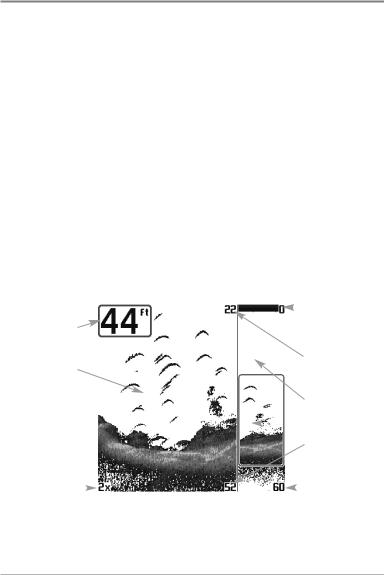
Sonar Zoom View
Sonar Zoom View provides a magnified view of the bottom and structure. The Sonar Zoom View makes it easier to see separate sonar returns that would usually be displayed close together, such as those caused by fish suspended close to the bottom or within structure.
•The Zoom Level, or magnification, is displayed in the lower left corner of the display. Press the MENU key once to access the Sonar X-Press™ Menu. Highlight Zoom Level, and press the LEFT or RIGHT Cursor keys to adjust the Zoom Level.
•The Zoomed View is displayed on the left side of the screen. As the depth changes, the zoomed view updates automatically.
•The Full Range View is displayed on the right side of the screen. The Full Range View includes the Zoom Preview Box, which shows where the zoomed view is in relation to the full range view.
•The Upper and Lower Depth Range numbers indicate the high and low range of the water which is being viewed.
|
|
|
Sonar Zoom View |
|||||
|
|
|
|
|
|
|
|
Upper Depth Range, |
Depth |
|
|
|
|
|
|
|
Full Range View |
|
|
|
|
|
|
|
|
|
|
|
|
|
|
|
|
|
Upper Depth Range, |
Zoomed View |
|
|
|
|
|
|
|
Zoom View |
|
|
|
|
|
|
|
|
Full Range View |
|
|
|
|
|
|
|
|
Zoom Preview Box |
|
|
|
|
|
|
|
|
|
|
|
|
|
|
|
|
|
Lower Depth Range, |
|
|
|
|
|
|
|
|
Zoom View |
Zoom Level |
|
|
|
|
|
|
|
Lower Depth Range, |
|
|
|
|
|
|
|
Full Range View |
|
|
|
|
|
|
|
|
||
|
|
Digital depth is displayed in the upper left hand corner. The |
||||||
|
|
digital readouts in the Sonar Zoom View cannot be |
||||||
|
|
customized; therefore, information such as water temperature |
||||||
|
|
and voltage are unavailable in the Sonar Zoom View. |
||||||
17 |
Views |

200/83 kHz Split Sonar View
Split Sonar View displays sonar returns from the 83 kHz wide beam on the left side of the screen and displays sonar returns from the 200 kHz narrow beam on the right side of the screen. Depth is displayed in the upper left hand corner. You can use the Split Sonar View to make side by side comparisons between the sonar returns from the 83 kHz wide beam and the 200 kHz narrow beam.
The digital readouts in the Split Sonar View cannot be customized; therefore, information such as water temperature and voltage are unavailable in the Split Sonar View.
|
|
|
200/83 kHz Split Sonar View |
|
|
|
|
|
Upper Depth |
|
|
|
|
|
Depth |
|
|
|
Range |
|
|
|||
|
200 kHz Sonar |
|
History Window |
83 kHz |
|
Sonar |
|
History |
Lower Depth |
Window |
Range |
Views |
18 |

Big Digits View
Big Digits View provides digital data in a large, easy-to-see format. Depth is always displayed. Readouts for temperature, speed, and Triplog information are displayed automatically if the appropriate accessory is connected to the system. The Triplog shows distance traveled, average speed, and time elapsed since the Triplog was last reset. The digital readouts in the Big Digits View cannot be customized.
Big Digits View
Depth
Temperature 
Speed
Timer shows the
time elapsed since Triplog was last reset
Distance is the distance traveled since the Triplog was last reset
Voltage displays the battery voltage
Average Speed shows the speed since the Triplog was last reset
19 |
Views |

Circular Flasher View
Circular Flasher View displays Real Time Sonar (RTS™) data in the traditional flasher format. Depth and temperature are always displayed. The digital readouts in the Circular Flasher View cannot be customized.
Views |
20 |

Side Beam View
(with optional-purchase QuadraBeam PLUS™ transducer)
Side Beam View is only available if you have connected an optional-purchase QuadraBeam PLUS™ transducer accessory and set Transducer Select to QuadraBeam (see Sonar Menu Tab: Transducer Select).
NOTE: The QuadraBeam PLUS™ transducer requires a separate purchase.
Side Beam View displays sonar data from the left and right 455 kHz beams and the 200 kHz down-looking beam in one view.
•The sonar information from the side-looking beams reveals bottom contour, structure, and fish similar to the down-looking beam, but the area covered is to the left and right, which gives you a wider view of the bottom.
•The Side Beam View can be arranged in any of the following layouts: Default, Classic, and Slanted.
To adjust the Quad Layout Setting for the Side Beam View:
1.From the Side Beam View, press the MENU key once to access the Sonar X-Press™ Menu.
2.Press the DOWN Cursor key to highlight Quad Layout.
3.Press the LEFT or RIGHT Cursor keys to change the Quad Layout setting for the Side Beam View. (Default, Classic, Slanted, Default = Default)
The distance covered by the right and left side-looking beams is controlled by the Depth Range setting for the down-looking beam, up to a maximum of 160 feet (see
Sonar Menu Tab: Depth Range).
21 |
Views |
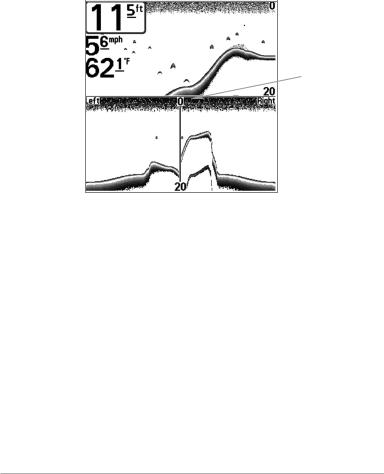
Default layout: The top portion of the display presents a historical log of sonar returns from the 200 kHz down-looking sonar beam. New information in the down beam panel scrolls from right to left. The bottom portion of the display presents a historical log of sonar returns from the 455 kHz rightand leftlooking sonar beams. New information in the side beam panels scrolls from the center out.
Depth 
Temperature 
Left Side 
455 kHz
Sonar History
Window
Side Beam View, Default Layout
 200 kHz Sonar
200 kHz Sonar
History Window
Water Surface Line for 455 kHz Sonar History Windows
 Right Side 455 kHz
Right Side 455 kHz
Sonar History
Window
Views |
22 |
